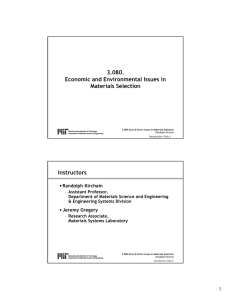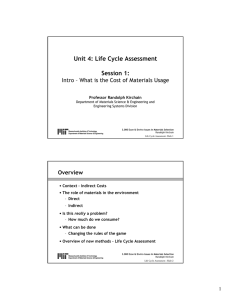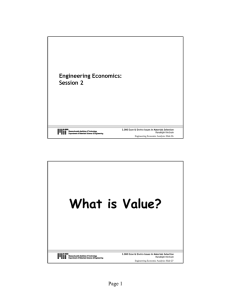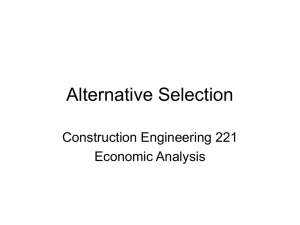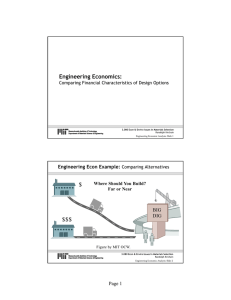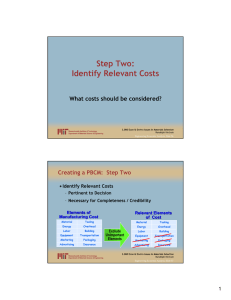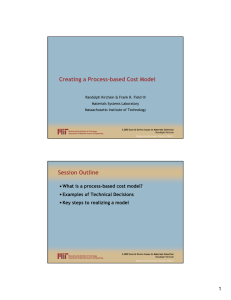Engineering Economics: Session 5 Randolph Kirchain
advertisement
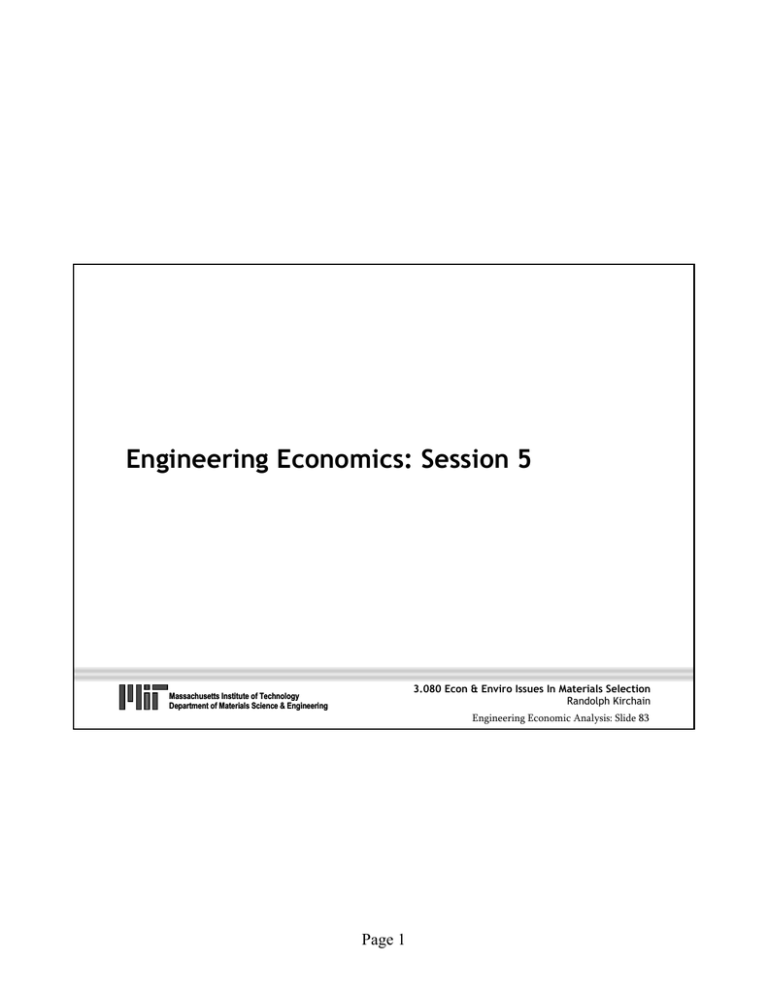
Engineering Economics: Session 5 3.080 Econ & Enviro Issues In Materials Selection Randolph Kirchain Massachusetts Institute of Technology Department of Materials Science & Engineering Engineering Economic Analysis: Slide 83 Page 1 Comparing Alternatives • Projects are acceptable if: – PW > 0 @ MARR – AW > 0 @ MARR – IRR > MARR • What if you are considering multiple alternatives which meet these criteria? • How do you select among alternative projects? 3.080 Econ & Enviro Issues In Materials Selection Randolph Kirchain Massachusetts Institute of Technology Department of Materials Science & Engineering Engineering Economic Analysis: Slide 84 Page 2 Ensuring Comparability • Before comparing multiple options, consider whether they are truly equivalent • Attempt to monetize those factors which differ • What about Useful Life? 3.080 Econ & Enviro Issues In Materials Selection Randolph Kirchain Massachusetts Institute of Technology Department of Materials Science & Engineering Engineering Economic Analysis: Slide 85 Page 3 Tackling Alternatives with Different Useful Lives • Study period (Planning Horizon) is the time period over which alternatives are to be compared 3.080 Econ & Enviro Issues In Materials Selection Randolph Kirchain Massachusetts Institute of Technology Department of Materials Science & Engineering Engineering Economic Analysis: Slide 86 Page 4 Tackling Alternatives with Different Useful Lives (cont) • Decision Cases: – Useful life of all alternatives = Study Period • No adjustments required – Useful life of at least one alternative ≠ Study Period • Repeatability – The study period is either infinite or equal to a common multiple of the useful lives of the alternatives – The cash flows associated with the first useful life are repeated throughout the study period • Cotermination – All alternatives are adjusted to reflect a common study period 3.080 Econ & Enviro Issues In Materials Selection Randolph Kirchain Massachusetts Institute of Technology Department of Materials Science & Engineering Engineering Economic Analysis: Slide 87 Page 5 Comparing Alternatives: Equivalent Worth • If Useful Lives are equal to study period Æ Alternative with greatest equivalent worth is preferred • Transitivity – If PWA > PWB, then AWA > AWB 3.080 Econ & Enviro Issues In Materials Selection Randolph Kirchain Massachusetts Institute of Technology Department of Materials Science & Engineering Engineering Economic Analysis: Slide 88 Page 6 Re-examining the Initial Example: Where Should You Build? Far or Near $ Where Should You Build? Far or Near BIG DIG $$$ Figure by MIT OCW. 3.080 Econ & Enviro Issues In Materials Selection Randolph Kirchain Massachusetts Institute of Technology Department of Materials Science & Engineering Engineering Economic Analysis: Slide 89 Page 7 Example: Comparing Alternatives MARR = 15%, Study Period = 120 Months Cost Cost to build @ site Site A Site B $250,000 $750,000 Monthly Costs Average Hauling Distance 10 3 miles Hauling Expense $5 $5 /mile 200 200 /month Shipments Monthly Cost $10,000 Monthly Revenue $20,000 Present Worth $679k $3,000 $20,000 /month $614k 3.080 Econ & Enviro Issues In Materials Selection Randolph Kirchain Massachusetts Institute of Technol Technology Department of Material Materials Sci Science & Engineeri Engineering Engineering Economic Analysis: Slide 90 Page 8 Near vs Far Cash Flows $2,500 Near - Nominal Aggregate Cash Flow $2,000 Far - Nominal $1,500 Near - PV $1,000 Far - PV $500 $0 ($500) 0 20 40 60 80 100 120 ($1,000) Months 3.080 Econ & Enviro Issues In Materials Selection Randolph Kirchain Massachusetts Institute of Technology Department of Materials Science & Engineering Engineering Economic Analysis: Slide 91 Page 9 Comparing Alternatives: IRR • As for all alternatives, lower investment is preferred, unless additional investment provides sufficient returns – Each increment of capital must produce a return > MARR – Select a higher investment only if the incremental investment provides returns > MARR 3.080 Econ & Enviro Issues In Materials Selection Randolph Kirchain Massachusetts Institute of Technology Department of Materials Science & Engineering Engineering Economic Analysis: Slide 92 Page 10 Comparing Alternatives IRR •Do NOT compare the IRRs of alternatives •Only compare IRRs against MARR 3.080 Econ & Enviro Issues In Materials Selection Randolph Kirchain Massachusetts Institute of Technology Department of Materials Science & Engineering Engineering Economic Analysis: Slide 93 Page 11 IRR Example 2 – Efficient Light Bulbs • Are energy efficient light bulbs worth it? • Bulb types Incandescent Expected Lifetime 750 Lumens 585 Wattage 60 Purchase Cost $0.50 Halogen 3,750 570 50 $3.25 Compact Fluorescent 7,500 600 15 $13.50 Compact Fluor2 7,500 600 14 $14.00 3.080 Econ & Enviro Issues In Materials Selection Randolph Kirchain Massachusetts Institute of Technol Technology Department of Material Materials Sci Science & Engineeri Engineering Engineering Economic Analysis: Slide 94 Page 12 IRR Example 2 – Efficient Light Bulbs Difference CF-Incand Difference CF2-Incand Year Incandescent Halogen CF CF2 Difference Hal-Incand 0 $0.50 $3.25 $13.50 $15.00 -$2.75 -$13.00 -$14.50 1 $2.75 $1.88 $0.56 $0.53 $0.88 $2.19 $2.23 2 $2.75 $1.88 $0.56 $0.53 $0.88 $2.19 $2.23 3 $2.75 $1.88 $0.56 $0.53 $0.88 $2.19 $2.23 4 $2.75 $1.88 $0.56 $0.53 $0.88 $2.19 $2.23 5 $2.75 $5.13 $0.56 $0.53 -$2.38 $2.19 $2.23 6 $2.75 $1.88 $0.56 $0.53 $0.88 $2.19 $2.23 7 $2.75 $1.88 $0.56 $0.53 $0.88 $2.19 $2.23 8 $2.75 $1.88 $0.56 $0.53 $0.88 $2.19 $2.23 9 $2.75 $1.88 $0.56 $0.53 $0.88 $2.19 $2.23 10 $2.25 $1.88 $0.56 $0.53 $0.38 $1.69 $1.73 Assumptions: Usage = 750 hrs / year; Electricity = $0.10 / kWh; Study Period = 10 years Massachusetts Institute of Technology Department of Materials Science & Engineering 3.080 Econ & Enviro Issues In Materials Selection Randolph Kirchain Engineering Economic Analysis: Slide 95 Page 13 IRR Example – Efficient Light Bulbs, MARR = 5% Net Cash Flows for Compact Fluorescent Net Cash Flows for Compact Fluor2 $4 $4 $2.19 $2.19 $2.19 $2.19 $2.19 $2.19 $2.19 $2.19 $2.19 $2 $2.23 $2.23 $2.23 $2.23 $2.23 $2.23 $2.23 $2.23 $2.23 $1.69 $2 $1.73 $0 $0 0 1 2 3 4 5 6 7 8 9 10 0 1 2 3 4 5 6 7 8 9 10 ($2) ($2) ($4) ($4) ($6) ($6) ($8) ($8) ($10) ($10) ($12) ($12) ($14) ($14) $14.5 $13.0 ($16) Massachusetts Institute of Technology Department of Materials Science & Engineering 3.080 Econ & Enviro Issues In Materials Selection Randolph Kirchain Engineering Economic Analysis: Slide 96 Page 14 IRR Example 2 – Efficient Light Bulbs We found that PWCF>PWCF2 Also, IRRCF>IRRCF2 Does this mean that we always prefer options with higher IRR? Total Present Worth $8 CF $6 CF2 $4 IRR=10.5% $2 $0 0% ($2) 5% 10% 15% 20% IRR=8% ($4) Discount Rate Massachusetts Institute of Technology Department of Materials Science & Engineering 3.080 Econ & Enviro Issues In Materials Selection Randolph Kirchain Engineering Economic Analysis: Slide 97 Page 15 IRR Ranking Does Not Always Match PW Total Present Worth $8 CF $6 $4 CF2 $2 Halogen 10.5% 13.9% $0 0% ($2) 5% 10% 15% 20% IRR=8% ($4) Discount Rate 3.080 Econ & Enviro Issues In Materials Selection Randolph Kirchain Massachusetts Institute of Technology Department of Materials Science & Engineering Engineering Economic Analysis: Slide 98 Page 16 IRR Ranking Procedure 1) Rank acceptable (IRR>MARR) alternatives based on investment 2) Find lowest investment acceptable (IRR>MARR) alternative (Base Alternative) 3) Develop Incremental Cash Flow for Next Alternative (i.e., in ranked list) a) Next Alternative Cash Flow – Base Alternative Cash Flow 4) Is Incremental Cash Flow acceptable (IRR>MARR) a) If yes, this is new Base Alternative b) If no, keep Base Alternative 5) Move to next alternative in ranked list and restart at 3 3.080 Econ & Enviro Issues In Materials Selection Randolph Kirchain Massachusetts Institute of Technology Department of Materials Science & Engineering Engineering Economic Analysis: Slide 99 Page 17
